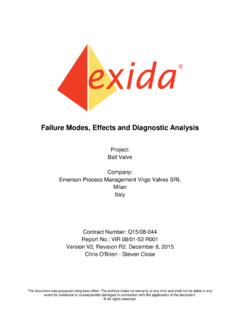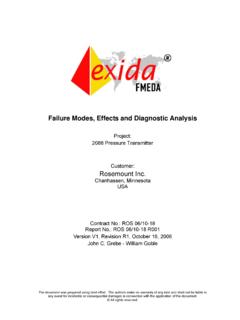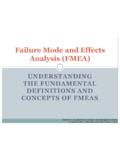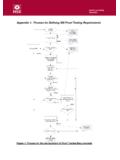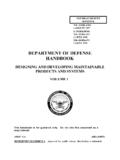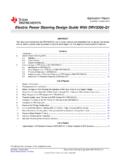Transcription of Rod Pumping Deviated Wells - ALRDC
1 Rod Pumping Deviated WellsAbstractMore and more directional Wells are being drilled to maximize hydrocarbon recovery and overcomeenvironmental s state-of-the-artpredictive software for rod Pumping can be used to design and optimize rod Pumping in deviatedwells as well as vertical Wells . Previously, traditionalmethods, including wave equation techniques,assume that the wellbore is vertical. Applying these methods to rod Pumping in Deviated Wells and inunintentionally Deviated (crooked) Wells will result in substantial errors and cause inappropriate new technique considers a deviation survey forthe 3-D borehole trajectory and rod/tubing dragfriction in the predictive design paperexamines a real case for a severely Deviated well byusing the new software, showing the best practicesand greater number of Deviated Wells are being drilledto increase production rates, and to minimize costand ecological damage.
2 Sucker rod Pumping has beenan efficient method in vertical Wells and is becomingmore and more common in Deviated Wells . Duringthe last several decades, the Deviated well waspresumed to be a vertical well in the design anddiagnosis of rod Pumping well , which is based on theone-dimensional, viscous-damped wave-equationcomputerized the model for vertical wellis imprecise and not valid for a crooked-hole or adeviated well . In 1992, the 3-D Deviated well modelbased on the modified version of wave equation wasoriginally developed by Dr. Sam Gibbs and has beensuccessfully incorporated into Lufkin Automation sSROD1rod Pumping predictive and design , Lufkin Automation developed and released anew version of the rod Pumping diagnostic program,DIAG, which uses a similar model and algorithm asSROD for diagnosing Deviated paperpresents the new wave equation methodology thatincorporates both viscous friction and drags design procedure for intentionally Deviated well ispresented.
3 Rod guide design is studied. Some otherimportant concerns such as drag friction, guidefriction coefficient, buckling and dogleg servility arediscussed. Finally, the effect of designing an optimumwellbore path before the well is drilled is Xu,Ken Nolen,Dennis Shipp, Andy Cordova,Sam GibbsLufkin Automation 2005 Lufkin is a trademark of Lufkin Automation.(LUF502/0405)NorGlide is a registered trademark ofNorris, a Dover more information 2 Rod Pumping Deviated WellsMathematical ModelGibbs introduced a 3-D modified wave equationmethod to predict and design rod Pumping indeviated governing equation of motionthat is solved to model rod Pumping performance indeviated Wells with rod dynamics, viscous frictionand drag friction is expressed as follows:(1)vrepresents acoustic velocity in the sucker the viscous damping coefficient, whichmodels the effects of fluid viscous friction.
4 (s) isthe friction coefficient function, which provides forvariation of friction coefficient along the rod string(due to bare rods and different types of rod guides).Q(s)and T(s)are functions, which depend on axialload and wellbore deviation. And g(s)is rod gravityeffect. In the vertical well case,g(s) constant andQ(s) T(s) 0; hence, Equation 1 reduces to thewave equation for vertical Wells . A 3-D visualizationof an element of the rod string as a free-bodydiagram in a Deviated well is shown in Figure 1 is solved with the finite differencemethod subject to the complicated boundaryconditions for the pump, surface unit and algorithm is developed in LufkinAutomation s SROD predictive is a comprehensive computerized mathematicalmodel program that is used to design a rod-pumpingsystem in vertical or Deviated latestversion of SROD features a simulation for hydraulicpumping units, such as DynaPump, with dual speedsfor upstroke and downstroke.
5 In addition, gas-enginesimulations have been improved, which includes theeffects of higher fly wheel rotary inertia. Also, indeviated Wells the placement of rod guides, thenumber of guides needed and their added weight tothe rod string are automatically included. 2u(s,t) 2u(s,t) u(s,t) v2 c t2 s2 t u(s,t) (s)[Q(s) T(s)] g(s) sFor more information Considerations in DeviatedWell DesignRod BucklingGenerally speaking, rod buckling can be caused bydownhole rod frictions and faster Pumping effect atfluid pound condition. Some unit geometryselections with faster trip on downstroke thanupstroke may aggravate buckling tendency at fluidpound condition. Under-balanced units may alsoaggravate buckling bottom portion of the rod string in pumpingwells is always in compression from buoyancy ondownstroke, but buoyancy will not cause of a rod string immersed in a fluid isgoverned by the buckling tendency rather than thetrue load or axial true load is useful forcalculating rod-loading base on stress-range diagramssuch as the API Modified Goodman if there is a tendency for rod buckling,one must carefully examine the buckling tendency at the bottom portion of the rod string.
6 Examples of true load (axial load) and buckling tendency are presented in Figure 7 or Figure 11. At depth of 10,116 ft on Figure 11, negative trueload 2842 lbs, buckling tendency difference between them ( 1836 lbs) reflectsthe fluid buoyancy the following equation for criticalload (lbs) necessary to buckle the rod.(2)where I moment of inertia of crosssection d4/64 (in4)E elastic modulus of rod _105(psi, for steel)w weight of rod in fluid wair(1 ) (lbs/ft)Fcritical 3 ( w)2/144page 3 Rod Pumping Deviated WellsThe criteria for buckling is that if the rod bucklingtendency, which includes rod dynamics effect, isgreater than Fcritical, then the rods can be expectedto buckle.
7 However, Equation 2 is only applicable tovertical Guide DesignIn rod Pumping Wells , the most expensive routinewell-servicing cost is the repair of tubing many cases, this wear is caused by side loads froma Deviated wellbore. Also, if rod buckling on thedownstroke is occurring, rod/tubing wear can result,which is typically near the there area few options to reduce rod/tubing wear, rod guidesalong with keeping full pump condition couldpossibly be the most practical and the most cost-effective method of controlling rod buckling androd/tubing wear problems. Basically, the rod guidesact as a sacrificial component to center the rodstring in the tubing so that wear on therods/couplings and the tubing is minimized.
8 However,different rod guide design criteria has existed in theindustry for a long time. One method, the trial anderror method, uses a statistical well failure well with similar conditions and equipped withrod guides is applied to a well that is not currentlyinstalled with rod guides. If the failure frequency orrod guide wear is greater than predicted, then moreguides are added the next time a failure , not only is it quite a costly method, butit is also generally limited by the amount ofinformation in the database. Other methods basedon buckling tendency and the static lab test areintroduced in papers [3] and [4].Rod guide design technology has been built intoSROD application which can be integrated with thecomprehensive wave equation solution, combiningrod dynamics, rod and guide properties, side load,rod frictions (viscous and drag), rod buckling, variouspump modes and actions, surface unit motion, andmotor , rod guide design andbuckling consideration are based on a real maximum side load on each rod iscalculated, and it is used to determine if the guide isneeded and how many rod guides are on the detail rod guide design, the programsimplifies the rod guide design with a maximum of10-rod sections for the purpose of practical fieldinstallation.
9 Rod guides may be required in a verticalwell too where buckling tendency is higher thantolerable. If so, buckling tendency plot is useful toperform rod guide lab tests indicated that the asymmetricalmolded guide spacing allowed higher critical Euler sload to buckle the rod than did the symmetricalmolded guide spacing. Based on the labobservations, it is recommended that at least onemolded guide should be closed to end of rodcoupling by about 15 and Viscous FrictionBare rod friction coefficient is the coefficient ofCoulomb friction between bare rod and of friction (COF) times the side load(normal force between the tubing and a sucker rod)is equal to the frictional drag force on the bare rod COF default value is COFdepends on the type of materials that are rubbing,the roughness of the surface and the lubricity (oilversus water, etc.)
10 This value can range from (oil lubricant and smooth surfaces) to about (water lubricant and rough surfaces).The COF canbe computed from dynamometer valve checks6ordetermined experimentally by trial and error. A trialand error solution requires a dynamometerdiagnostic analysis (DIAG) and selecting a COF forthe design program (SROD) that results in goodagreement between the design and of guide friction to bare rod friction is used toadjust bare rod friction if rod guides are guides are added in the rod string, the relativefriction effects of various guides are expressed asratios to the frictional effects of bare ratio default value for molded guides is ,which indicates that molded guides increase frictionby 50% when compared to bare defaultvalue for wheeled guides is , which indicateswheeled guides will lower friction by 90% whencompared to bare rods.

